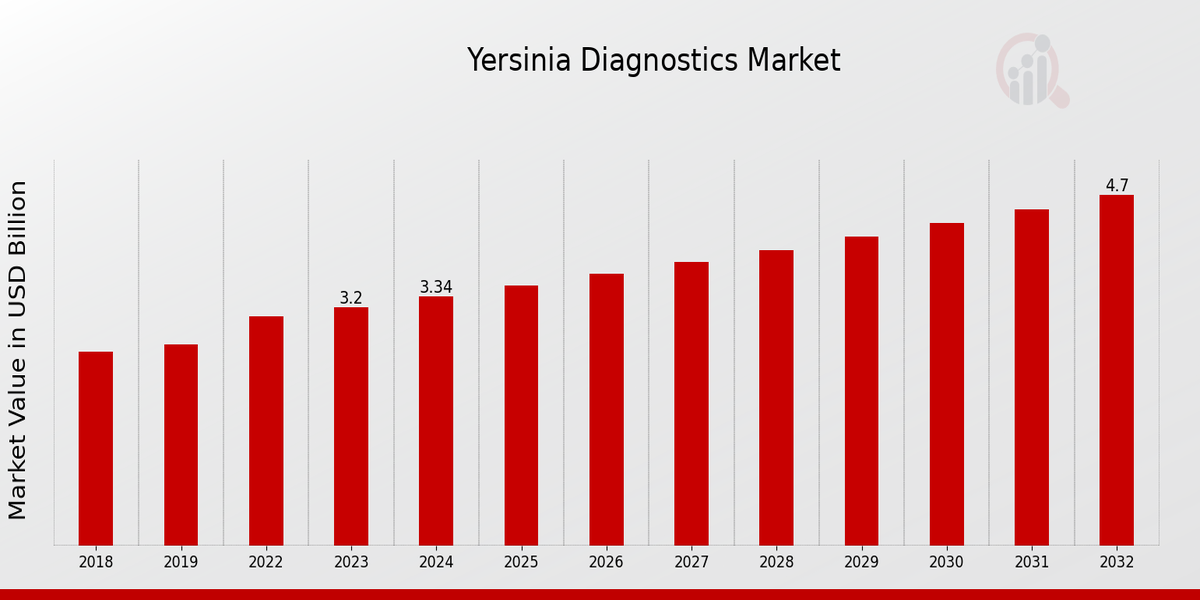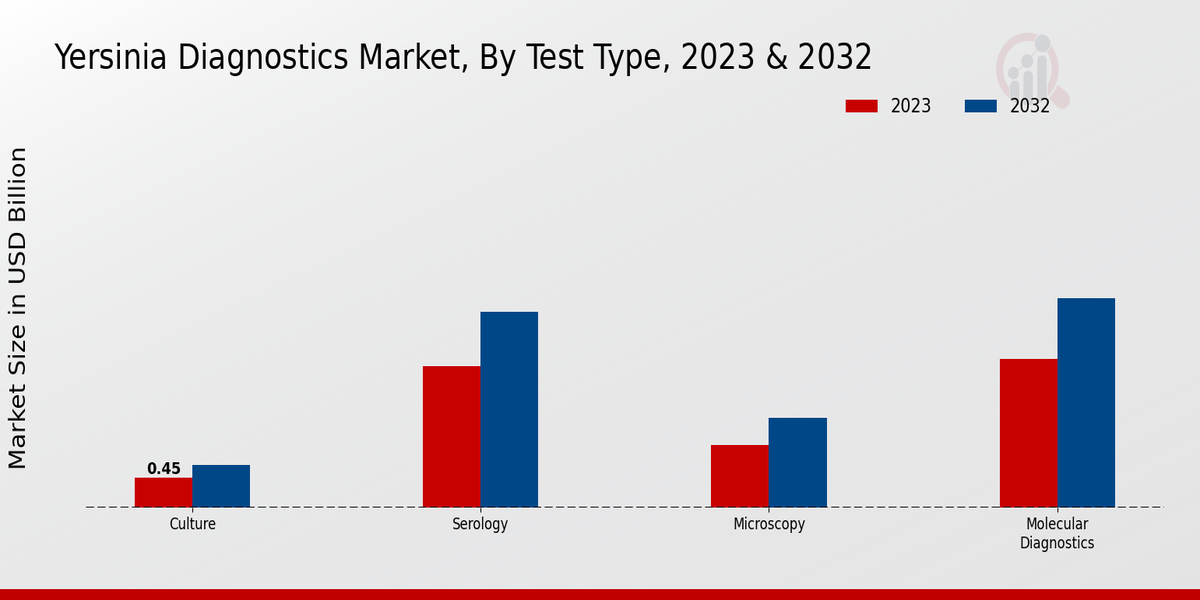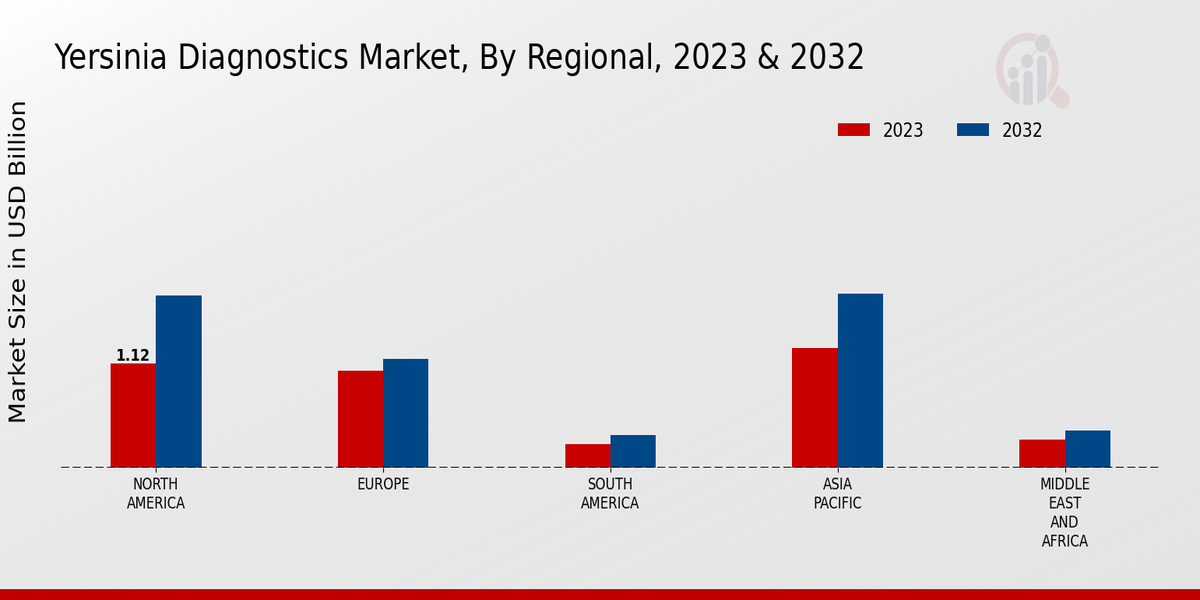Yersinia Diagnostics Market Overview
As per MRFR analysis, the Yersinia Diagnostics Market Size was estimated at 3.07 (USD Billion) in 2022. The Yersinia Diagnostics Market Industry is expected to grow from 3.2 (USD Billion) in 2023 to 4.7 (USD Billion) by 2032. The Yersinia Diagnostics Market CAGR (growth rate) is expected to be around 4.36% during the forecast period (2024 - 2032).
Key Yersinia Diagnostics Market Trends Highlighted
The Yersinia Diagnostics Market possesses distinct growth trends that define its scope. New technologies in molecular diagnostics, such as real-time PCR and automated nucleic acid extraction systems, make Yersinia testing more accurate and faster. The advent of rapid diagnostic tests, such as lateral flow immunoassays and biosensors, allows the diagnosis to be done at the point of care, which broadens the reach of testing. In addition, the increasing incidence rate of chronic diseases such as gastrointestinal diseases and arthritis, which are secondary to Yersinia infections, increases the need for effective and dependable diagnostic methods. In addition, with the growing popularity of the personalized medicine concept, it is important to identify the species of Yersinia for targeted antimicrobial treatment properly. These trends are expected to boost the growth of the Yersinia Diagnostics Market in the forecast period.

Source: Primary Research, Secondary Research, MRFR Database and Analyst Review
Yersinia Diagnostics Market Drivers
Technological Advancements in Diagnostic Techniques
The Yersinia Diagnostics Market industry is in good health, a trend attributed to the development of diagnostic kits and assays that are effective, sensitive, and faster than their predecessors, thanks to advancements in diagnostic technologies. Similarly, the introduction of rapid antigen tests and molecular diagnostics, alongside the development of quantitative PCR assays, has made it possible for health professionals to make informed diagnostic decisions, thereby increasing efficacy in patient management. More importantly, the introduction of multiplex polymerase chain reaction assays and biosensor technologies to detect concurrent detection of multiple Yersinia strains has enhanced efficiency in diagnosing the condition while saving on costs. Over the next years, further development of these methods and other technologies will continue to play a critical role in expanding the industry.
Increasing Prevalence of Yersinia Infections
One of the primary drivers of the Yersinia Diagnostics Market Industry is the continuously increasing incidence of Yersinia infections across the globe. Yersinia bacteria have been known to cause a range of different diseases, among which are gastroenteritis, septicemia, and meningitis. The latter has considerable health implications, and any of these severe infections can result in severe health complications if left untreated. The growing prevalence is fueled by factors such as changing dieting trends, globalization, and climate change.As the incidence tends to go up constantly, the demand for the corresponding diagnostics grows simultaneously.
Rising Awareness and Government Initiatives
One of the main drivers of the Yersinia Diagnostics Market Industry is the increasing awareness among healthcare providers and the general public regarding the importance of early detection and treatment of these infections. In addition, government initiative programs and health organization campaigns have been aimed at educating individuals regarding the risks associated with Yersinia infections and encouraging them to get themselves diagnosed on time.Moreover, Government investments in the research and development of advanced diagnostic systems and technologies have served as another essential driver.
Yersinia Diagnostics Market Segment Insights
Yersinia Diagnostics Market Test Type Insights
The Yersinia Diagnostics Market is segmented by Test Type into Serology, Molecular Diagnostics, Microscopy, and Culture. Serology is the most widely used test type, accounting for around 45% of the global market revenue in 2023. This dominance is primarily attributed to its cost-effectiveness, simplicity, and ability to detect antibodies against Yersinia species in serum or plasma samples. Molecular Diagnostics, on the other hand, is gaining significant traction due to its high specificity and sensitivity. It involves techniques such as Polymerase Chain Reaction (PCR) and Nucleic Acid Amplification Tests (NAATs), which can detect the presence of Yersinia DNA or RNA in clinical specimens.
The increasing adoption of molecular diagnostics in clinical laboratories and reference centers is expected to drive the growth of this segment over the forecast period. Microscopy, though less commonly used compared to serology and molecular diagnostics, plays a crucial role in the initial diagnosis of Yersinia infections. It involves the examination of stained clinical specimens under a microscope to visualize Yersinia bacteria. Culture, another traditional test type, involves the isolation and growth of Yersinia species from clinical samples on selective culture media. While culture is time-consuming and requires specialized expertise, it remains an important confirmatory test for Yersinia infections, especially in cases where serological or molecular diagnostics results are inconclusive. Overall, the market segmentation by Test Type reflects the diverse range of diagnostic approaches available for Yersinia infections, each with its advantages and limitations. The choice of test type depends on factors such as the clinical presentation, availability of resources, and desired level of sensitivity and specificity.

Source: Primary Research, Secondary Research, MRFR Database and Analyst Review
Yersinia Diagnostics Market Infection Type Insights
Insight from Yersinia Diagnostics Market segmentation by Infection Type- Plague, Yersiniosis The insight from Yersinia Diagnostics Market segmentation by Infection Type provides an in-depth analysis of unique features and dynamics in the two infections. First, the plague is a severe bacterial infection caused by Yersinia pestis, and it is associated with high mortality if not treated early. Accordingly, the Plague diagnostics market is expected to experience the highest levels of growth due to increasingly rising instances of the disease, especially in the developing world.More importantly, the development of new plague diagnostics will be an interesting trend in the coming years. Yersiniosis is also a type of Yersinia infection, and it is associated with less severity, although it is more prevalent. The diagnostics in the market are expected to witness moderate levels of growth because of the increasing demand for diagnostics to detect the infection in the foodstuffs. In conclusion, the insight and analysis of the market segmentation based on the infection type of the two diseases suggest that the Yersinia Diagnostics Market will experience significant growth in the coming years.
Yersinia Diagnostics Market Specimen Type Insights
The Yersinia Diagnostics Market is segmented by specimen type into blood, tissue, and fluid. The blood segment is expected to account for the largest share of the market in 2023 due to the high prevalence of yersiniosis and the availability of a wide range of blood tests for the diagnosis of the disease. The tissue segment is expected to grow at the fastest rate during the forecast period due to the increasing use of tissue biopsies for the diagnosis of yersiniosis. The fluid segment is expected to account for a small share of the market in 2023 but is expected to grow at a steady rate during the forecast period.
Yersinia Diagnostics Market End User Insights
The Yersinia Diagnostics Market Segmentation by End User into Hospitals and Clinics and Diagnostic Laboratories provides valuable insights into the market dynamics. The hospitals and Clinics segment held a significant market share in 2023, owing to the increasing prevalence of Yersinia infections and the availability of advanced diagnostic facilities in these settings. The rising number of hospitalizations due to Yersinia infections, along with the growing demand for rapid and accurate diagnosis, is driving the growth of this segment. Additionally, the presence of skilled healthcare professionals and advanced infrastructure in hospitals and clinics contributes to the segment's growth.Diagnostic Laboratories segment is anticipated to witness substantial growth over the forecast period 2023-2032. The increasing focus on outsourcing diagnostic services, coupled with the availability of specialized equipment and expertise in these laboratories, is fueling the demand for Yersinia diagnostics in this segment. The growing adoption of molecular and immunological techniques for Yersinia detection is also contributing to the segment's growth.
Yersinia Diagnostics Market Regional Insights
Regionally, North America is expected to account for the largest market share of over 35% in 2023, followed by Europe and APAC. North America's dominance can be attributed to the high prevalence of yersiniosis, favorable reimbursement policies, and the presence of key market players. Europe is another significant market driven by government initiatives to enhance healthcare infrastructure and the availability of advanced diagnostic techniques. APAC is projected to witness the highest growth rate during the forecast period due to the rising awareness of yersiniosis, increasing healthcare expenditure, and the growing adoption of molecular diagnostics.South America and MEA are expected to contribute a relatively smaller share of the global market but are likely to experience steady growth in the coming years.

Source: Primary Research, Secondary Research, MRFR Database and Analyst Review
Yersinia Diagnostics Market Key Players And Competitive Insights
The major players in the Yersinia Diagnostics Market industry are involved in attracting customers to gain a competitive advantage through strategic partnerships, acquisitions, and the development of new products. Leading players are focusing on extensive investments in R&D activities to develop new products and serve the increasing demand of healthcare professionals. The development of the Yersinia Diagnostics Market is characterized by diagnostic companies collaborating with pharmaceutical companies to develop companion diagnostics for Yersinia infections. This is expected to play a substantial role in the growth of the Yersinia Diagnostics Market. The leading player in the market is bioMérieux, a multinational group based in France. The company operates in the diagnostics market and provides diagnostic solutions that determine the cause of disease and contamination. bioMérieux provides several Yersinia diagnostic tests, such as VIDAS Yersinia enterocolitica and VIDAS Yersinia pseudotuberculosis. This global company is known for the high quality of its products and services, and it is expected to remain in a leading position as it is investing in the development and expansion of products.
Yersinia Diagnostics' Market competitor is BD, or Becton, Dickinson and Company. It is an international healthcare technology company operating worldwide. BD is focused on improving the delivery of healthcare and the development of new medical technologies. Leading the market of Yersinia Diagnostics, the company provides several tests, including the BD MAX Enteric Parasite Panel, BD Phoenix Automated Microbiology System, and others. BD is constantly investing in R&D activities to develop new products and maintain its position in the market.
Key Companies in the Yersinia Diagnostics Market Include
- Grifols (Progenika Biopharma)
- BioRad Laboratories
- Alere (Abbott)
- Cepheid
- Hologic
- Danaher Corporation
- BioTechne Corporation
- Biomerieux
- QIAGEN
- Siemens Healthineers
- LGC (formerly LGC Genomics)
- BD (Becton, Dickinson and Company)
- Randox Laboratories
- Thermo Fisher Scientific
- Sysmex Corporation
Yersinia Diagnostics Market Industry Developments
The Yersinia diagnostics market is poised to experience steady growth between 2024 and 2032, driven by the increasing prevalence of yersiniosis, technological advancements in diagnostic techniques, and rising awareness about the disease. The market is expected to reach a valuation of USD 3.2 billion by 2032, expanding at a CAGR of 4.36% during the forecast period. Key players in the market include bioMérieux, BD, Thermo Fisher Scientific, and Cepheid.Recent developments in the market include the launch of new diagnostic assays and the expansion of molecular diagnostics. For instance, in 2023, BD launched the BD MAX Enteric Parasite Panel, a multiplex PCR assay for the detection of Yersinia enterocolitica. Additionally, Cepheid received FDA clearance for the Xpert Xpress Yersinia pestis assay, a rapid molecular diagnostic test for plague. These advancements are expected to contribute to the growth of the Yersinia diagnostics market in the coming years.
Yersinia Diagnostics Market Segmentation Insights
Yersinia Diagnostics Market Test Type Outlook
- Serology
- Molecular Diagnostics
- Microscopy
- Culture
Yersinia Diagnostics Market Infection Type Outlook
Yersinia Diagnostics Market Specimen Type Outlook
Yersinia Diagnostics Market End User Outlook
- Hospitals and Clinics
- Diagnostic Laboratories
Yersinia Diagnostics Market Regional Outlook
- North America
- Europe
- South America
- Asia-Pacific
- Middle East and Africa
| Report Attribute/Metric |
Details |
| Market Size 2022 |
3.07 (USD Billion) |
| Market Size 2023 |
3.2 (USD Billion) |
| Market Size 2032 |
4.7 (USD Billion) |
| Compound Annual Growth Rate (CAGR) |
4.36% (2024 - 2032) |
| Report Coverage |
Revenue Forecast, Competitive Landscape, Growth Factors, and Trends |
| Base Year |
2023 |
| Market Forecast Period |
2024 - 2032 |
| Historical Data |
2019 - 2022 |
| Market Forecast Units |
USD Billion |
| Key Companies Profiled |
Grifols (Progenika Biopharma), BioRad Laboratories, Alere (Abbott), Cepheid, Hologic, Danaher Corporation, BioTechne Corporation, Biomerieux, QIAGEN, Siemens Healthineers, LGC (formerly LGC Genomics), BD (Becton, Dickinson and Company), Randox Laboratories, Thermo Fisher Scientific, Sysmex Corporation |
| Segments Covered |
Test Type, Infection Type, Specimen Type, End User, Regional |
| Key Market Opportunities |
Increased disease prevalence Technological advancements Growing awareness Expanding healthcare infrastructure and Government initiatives |
| Key Market Dynamics |
Growing prevalence of yersiniosis Rising awareness about yersinia infections Technological advancements in diagnostic methods Increasing RampD activities Government initiatives to promote yersinia diagnostics |
| Countries Covered |
North America, Europe, APAC, South America, MEA |
Frequently Asked Questions (FAQ) :
The Yersinia Diagnostics Market is estimated to be valued at USD 3.2 billion in 2023 and is projected to reach USD 4.7 billion by 2032, exhibiting a CAGR of 4.36% during the forecast period.
North America is expected to dominate the Yersinia Diagnostics Market throughout the forecast period, owing to the rising prevalence of Yersinia infections, well-developed healthcare infrastructure, and increasing research and development activities in the region.
The increasing incidence of Yersinia infections, technological advancements in diagnostic techniques, and growing awareness about Yersinia-related diseases are the primary factors driving the growth of the market.
Yersinia Diagnostics are primarily used for the detection and identification of Yersinia species, which cause infections such as yersiniosis and plague. These diagnostics are employed in clinical settings, research laboratories, and food safety testing facilities.
Some of the prominent players in the Yersinia Diagnostics Market include bioMérieux, BD, Hologic, Abbott, and Thermo Fisher Scientific, among others.
The challenges faced by the market include the lack of standardized diagnostic methods, the high cost of advanced diagnostic technologies, and the need for skilled professionals to operate and interpret the results.
The future of the market is expected to be driven by the adoption of molecular diagnostics, the development of rapid and point-of-care testing devices, and the increasing focus on personalized medicine.
The COVID-19 pandemic has had a limited impact on the Yersinia Diagnostics Market. While there was a temporary decline in demand for diagnostic tests during the early stages of the pandemic, the market has since recovered and is expected to continue growing in the coming years.
Yersinia Diagnostics are regulated as medical devices in most countries. Manufacturers must comply with applicable regulations to ensure the accuracy, reliability, and safety of their products.
Reimbursement policies for Yersinia Diagnostics vary depending on the healthcare system and insurance coverage in each country. Some countries provide full or partial reimbursement for diagnostic tests, while others may require patients to pay out-of-pocket.

















